| Part
I: Hull Construction
Part II: Outfitting
Part III: Performance
Kayleigh : 18' Sharpie Camp Cruiser - Part III: Performance
I was on my way to the 2009 Summer Solstice on the Columbia River
near Portland, Oregon, and had stopped at a rest stop. As I got
out of the car this little boy (6 or 7 years old) came running
up to the boat all excited - "Wow, I really like your boat.
That's a real boat!"
Leave it to the spontaneous honesty of children. I wholeheartedly
agree with his observation, and authenticity of judgment. Usually
the comments of bystanders are more on the order of, "Nice
boat, how fast does it go?"
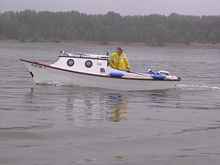 |
I'll admit she looks fast! Marsh Hawk and I
running up the Multnomah Channel on the Columbia River near
Portland, Oregon, on an off and on stormy day. Of interest
here is my helm position and the universal tiller extension
which steers the motor and controls the throttle. She's doing
~ 5.5 mph here, a comfortable speed for the hull and engine.
Notice the near perform wave form along the hull - the bow
wave attenuated just where the aft twin skegs begin - then
the stern wave following the rocker of the aft hull sections.
A very gentle wake at this speed. (Pat Patteson) |
The Kayleigh design has a maximum hull speed of ~ 6.5 mph with
a 6hp engine running @ about ¾ throttle. This is a 1970's
two cylinder two cycle outboard engine. I have Doel-Fins on the
engine to prevent squatting. More power just results in more squatting
with no additional speed. The most comfortable running speed for
this hull and engine combination is 5.5 mph, about the speed of
the average family cruising sailboat. As discussed in Part
II, this is a displacement hull with a lot of rocker
and small transom footprint. Stable, smooth riding, rough water
capable, but not fast. Fellow Coot buddy, Mark Neuhaus from Portland
runs a brand new 6 hp 4 cycle Tohatsu outboard on his sister ship
"Turtle."
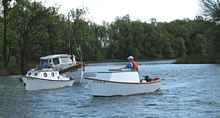 |
Getting ready to anchor in a slough off the
Multnomah Channel of the Columbia River near Scappoose, Oregon
are Kayleighs "Marsh Hawk" on left, and sister ship"Turtle"
[not quite finished] on right. In the background is Robin
Robinson's fine all weather cruiser [I forget the design name]
(Patteson) |
We ran side by side at various times comparing the performance
of these two boats. I had a much heavier load than Mark did and
my hull was immersed at both ends. Turtle, on the other hand had
both ends out and she was slightly faster than Marsh Hawk with
a lot less wake at comparable speeds. With his Tohatsu single
cylinder four stroke motor he also got much fuel mileage than
I did. He used somewhat less that 3 gallons for the ~ 60 mile
trip, while I used about 6 gallons or so. We were not running
very hard since we were trying to save fuel as the current was
stronger than we expected and there was no fuel to be had at the
closed marinas. When we asked around about this we were told that
a lot of the marinas were closed because it was too early in the
season, as well as the poor economy. We later learned that some
of the large marinas and dealers along the Willamette and Columbia
rivers were not making it and had to close permanently. I observed
many very expensive yachts in various moorages along the way that
appeared to have been abandoned altogether. Millions of dollars
worth of boats wasting away.
At this time of year the river was high and current in the channel
where we were going upstream was 1.5 - 2 mph. Therefore just to
maintain 4 to 5 mph we had to use more throttle for this speed
than we figured. In order to estimate how much fuel I would need
for this voyage I did several test runs on a lake near where I
live to see exactly how much fuel my 6 hp twin two stroke was
burning. Using 1 gallon test runs it went for ~ 1 hour and fifteen
minutes on a gallon of mix. A little hard to figure since the
tanks don't scavenge completely. If my math is correct that equals
0.8 gal/hour. What really surprised me is that it didn't seem
to matter what throttle setting I used, it was never less. If
I ran full throttle (~ 6.4 mph) it used 1 gal/hr. I was expecting
it would burn less at lower throttle settings, like 0.75 or 0.5
gal/hr. That's not a lot fuel, but still disappointing, since
Mark's engine must have been using ~ 0.5 gal/hr or less!
As an auxiliary engine I use a 46# thrust Min-Kota Electric mounted
on the transom and connected to a 125 amp hour (ah) 12 volt deep
cycle battery via a jumper cable. With the jumper cable clamps
it is easy to connect to the battery which is located underneath
the starboard bunk at the aft cabin bulkhead. I have triple outlet
+ USB receptacle connected to the battery. From this I run the
depth finder, GPS, radios and charging devices along with a computer
as needed (I also have small converter available to plug in here).
All connectors are the lighter type plugs. To keep the battery
charged I use a 1.7 ah /day flexible solar pad on top of the cabin.
I never have any battery problems. Wired into the battery and
mounted on the aft cabin bulkhead inside is a push-button meter
that tells me the state of charge on the battery. I have yet to
see it less than "full charge."
The Min-Kota 46 # thrust motor pushes the hull at ~ 3.5 mph at
the max setting. I figure I have a maximum of ~ 3 hours battery
time (below is a table showing calculations for speed/run-time
settings). Theoretically this is enough time and enough speed
reserve to get me to a safe place on the river or in the San Juans
to iron out problems with the outboard motor. This is the same
set up I had on the Baymaster sailboat (previously shown). It
saved the day one time at Sucia Island in the San Juans.
We were just outside of Fox Cove when I smelled something hot.
I turned around and the outboard was steaming like crazy. We were
just at the entrance of the cove and there were many boats about,
the mooring dock was packed full and the tidal current was carrying
us to the beach. I immediately shut down the outboard, hooked
up the electric and managed to maneuver to the dock with it. At
the dock I removed the outboard and found a piece of seaweed leaf
plastered tight to the water intake. Easy fix and we were back
in business. But without the electric auxiliary, problems would
have quickly multiplied. You never know when you might need auxiliary
power.
To summarize the speed performances for the 6hp twin cylinder
two stroke Evinrude Long Shaft outboard in the inboard well of
the Kayleigh with ~ 500# payload in calm lake water.
- Top speed = 6.5 mph.
- Cruising speed = 5.5 mph.
- Fuel consumption = ~ .8 gph.
- Tankage = 4 x 3g tanks
- Run time / tank = ~ 3.75 hr.
- Range / tank = ~ 20 mi.
- Max run time = ~ 15hr.
- Max range w/o refueling = ~ 75 mi (all estimates are theoretical
and conservative)
Those are all nice numbers, making the Kayleigh a very economical
boat to run. However these theoretical predictions made on the
basis of some tests never quite seem to work out on the water.
One can never know for sure how many gallons one has used from
those pressure tanks. Further, unless one keeps a dead reckoning
account via GPS and gallonage you never know know for sure how
far for how long you have been running. I tend to do a lot of
poking around and wondering about from any preplotted routes,
sometimes back tracking, sometimes stopping etc. All one can do
is estimate how much fuel they will need and then stay well within
those estimations.
Performance with the Min-Kota as per above conditions:
GPS Measured Speed vs. Estimated Run Time via 100ah Battery @
50 - 75% discharge:
Measured Speeds are based on average runs in calm lake water.
Speed Setting 5 = 3.4 mph = 1.78 hr
4 = 2.4 " = 2.1 "
3 = 2.2 " = 2.5 "
2 = 1.6 " = 3.07 "
1 = 1.5 = 3.8 "
All my assumptions and calculations are subject to correction.
The results of such calculations are theoretical and should be
tested in real life conditions on your boat with your motor and
battery in your boating environment.
The following pictures are of my Kayleigh ("Marsh Hawk")
in various aspects of her performance with comments of what characteristics
each photo is intended to demonstrate.
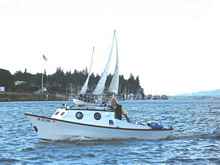 |
This is the best example of Marsh Hawk's attitude
in wind chop running against the river tidal current upon
entering the Multnomah Channel from the Columbia River. Note
that the sailboat in the background is full & by, while
Marsh Hawk's attitude has the bow anti slap pad really doing
the breakwater function for which it was designed. This area
of the river is the confluence of the channel, the main river
and Lake River, just off the downriver point of Sauvies Island.
It was stormy that day with winds swirling the compass at
~ 25mph, with currents and waves coming from all directions.
While this photo is at one of the calmer spots the angle of
the camera does not reveal the wave/trough action. To look
at the water from the helm was somewhat unnerving but I was
very impressed with the boat's handling characteristics. She
was very surefooted, steady in her tracking and quiet. The
ride was actually relaxing. (Patteson) |
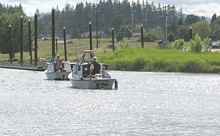 |
Marsh Hawk and Turtle running upstream in the
channel. Note that Turtle is higher on her lines than Marsh
Hawk and that the profile of the outboard on Turtle is lower
than Marsh Hawk's motor. I raised my motor board from the
plan specs to accommodate a long shaft motor, while Mark stuck
to the short shaft board measurements. I don't know if this
makes any real difference or not, I just feel safer with more
free-board in the motor well. (Patteson) |
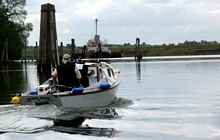 |
Some parts of the circumnavigation of Sauvie's
Island were quite serene and beautiful. Zoom in on this photo
and you can see exactly how I have my helm navigation station
set up. Here I am also referring to a paper chart clamped
to the top of the hatch. The yellow ball at the port side
of the transom is an anchor retrieval system. The anchor line
is fed through a friction lock fair-lead/guide then through
a pulley release system near the ball. To anchor, the anchor
and the ball/pulley system is released over board. When the
anchor is set, I pull on the inboard end of the rode and the
line is locked into position. The ball stays near the boat,
just overboard. To pick up the anchor, I pull the ball toward
the anchor and it picks up line and the anchor as I approach
it. It makes for very easy and safe anchoring off the stern
from the cockpit where the anchor is stowed. (Patteson) |
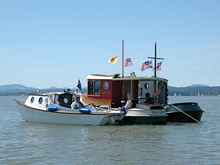 |
Marsh Hawk rafted up with mini-tugs on Fern
Ridge Lake near Eugene, Oregon. For size comparison, Marsh
Hawk is 18' with a highly rockered flat bottom, low topsides
and tucked transom. The tug in the middle ("Sea Weed")
is 15', totally freehand designed (no plans) and built by
Dick Mitsch from Lebanon, Oregon. The tug to the right on
the outside is a Candu EZ design www.berkeleyengineering.com
stretched to 18' and built by Dennis Banta from
Albany, Oregon. Both tugs are totally flat bottomed with no
rocker. The CanduEZ is electric powered. Seaweed has a 6hp
outboard in a well. We all have about the same hull speeds.
(John Kohnen) |
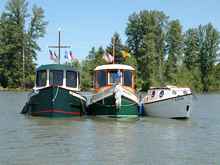 |
I thought a lot about building a tug before
I chose the Kayleigh design. In fact I spent one whole winter
redesigning (making it 18' instead of 15') the Bolger Microtrawler,
and making a detailed 1' scale model. The real boat would
have been 18+ lwl and 8'+ beam and a lot of windage. Comparing
the superstructures of the tugs and Marsh Hawk, one can see
why they call them "Harbor Tugs". Windage is a big
issue when trying to dock or when cruising rivers or the Puget
Sound. Another reason why I chose the Kayleigh design. With
some regret I chose control over "Chick Appeal."
This view also illustrates the "dory" characteristics
of the Kayleigh design high clipper bow. Another rough water
handling feature. Control features I have added are an extension
on the gear control lever of the outboard so I can reach it
easily from the helm position; a "monkey stick"
steering system [see article on same in Duckworks
Magazine]; and a "universal joint" extension
handle on the outboard tiller/speed control and a nice folding
stool to sit on at the helm. These all serve to make handling
easy and comfortable from a sitting helm position. I can reach
behind me to control shifting, I can control speed and steering,
from anywhere in the cockpit, or I can steer and control speed
sitting down at the helm position. (Kohnen) |
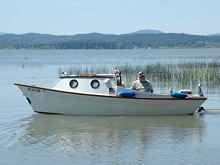 |
Marsh Hawk at home in her element, gunkholing
in marsh grass on Fern Ridge Lake. She draws 6". The
outboard motor prop is no lower than the twin aft skegs (a
design feature of the high rocker which allows shallow setting
for cavitation plate of the motor). This feature along with
the tucked transom and large outboard well opening in the
transom allows for safe anchoring from the stern in currents
that would not be safe to anchor stern 1st with a planing
hull - a white water dory feature. (Kohnen) |
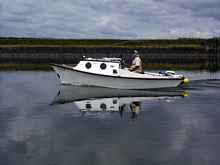 |
Perfect serenity - a dream made real. Reading
Sam McKinney's "Reach
of Tide" (his gunk-holing exploration of
the lower Columbia River) got me hooked on getting a boat
with which I could do this same thing. After I got the plans
I kept an 8" x 10" copy of the lines drawings by
my bed memorizing every detail, figuring out how I was going
to do it, and for the year and half it took me to built her
I dreamed about this image every night. (Patteson) |
(Photo Credits as Noted)
Copyrighted 2010 by Terry Lesh
First E rights to Duckworks Magazine. Others by permission only
*****

|

